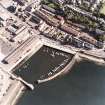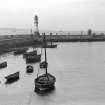Pricing Change
New pricing for orders of material from this site will come into place shortly. Charges for supply of digital images, digitisation on demand, prints and licensing will be altered.
Edinburgh, Newhaven, Pier Place, Harbour
Harbour (19th Century)
Site Name Edinburgh, Newhaven, Pier Place, Harbour
Classification Harbour (19th Century)
Alternative Name(s) Edinburgh, Leith Docks, Newhaven Harbour
Canmore ID 52000
Site Number NT27NE 76
NGR NT 25459 77146
NGR Description Centred NT 25459 77146
Datum OSGB36 - NGR
Permalink http://canmore.org.uk/site/52000
- Council Edinburgh, City Of
- Parish Edinburgh (Edinburgh, City Of)
- Former Region Lothian
- Former District City Of Edinburgh
- Former County Midlothian
NT27NE 76.00 centred 25459 77146
NT27NE 76.01 NT 25545 77188 Fish Market
NT27NE 76.02 NT 25438 77241 Western lighthouse (Beacon)
NT27NE 76.03 NT 25481 77241 Eastern lighthouse (Beacon)
NT27NE 76.04 NT 25438 77214 to NT c. 25407 77066 West Breakwater ('New Breakwater')
NT27NE 76.05 NT 25435 77238 to NT c. 25484 77239 North Pier ('Newhaven Pier')
For (adjoining) Leith Docks, see NT27NE 57.00.
See also:
NT27NE 14 NT 25479 77037 St James's Chapel
Newhaven Harbour [NAT] (name centred NT 25455 77147)
OS (GIS) AIB, July 2006.
SCOTTISH RECORD OFFICE:
Plans: RHP 9323, RHP 9325 1899 & 1921
(Undated) information in NMRS.
(Location cited as NT 254 771). Newhaven, Edinburgh. Newhaven first comes to historical notice at the beginning of the 16th century, when James IV chose it as the site of a naval dockyard, introduced a body of workpeople, and, in 1506, founded a chapel (NT27NE 14) for their benefit. The haven evidently comprised an ordinary harbour as well as a shipbuilding yard, as the charter of 1510-11, by which the place was given to Edinburgh, mentionsa bulwarks and defences for protecting ships as well as a foreshore to which they could be anchored, with their cables led inland as far as the inner frontage ('frontem interiorem') of some houses on the S side of the village street. Whether one or two piers existed at this time is doubtful, as the charter uses both the singular and the plural - in one passage 'munitionem, videlicet le pere et bulwark' and in another 'in le bulwarkis' - but in 1556 there were certainly two as a 'west bulwerk' is mentioned. With this record the Petworth House plan of Leith (1560) is in agreement, as it shows two piers built out from the shore on what look like bulwark foundations, the W pier inclining somewhat towards the E one as if to shorten the open N side. No doubt the shore between the piers was left in its natural state, so that vessels could be beached and secured in the manner indicated in the charter. The Petworth House plan shows no trace of the dockyard, which had no doubt disappeared by 1560, but some remains of a harbour survived in 1703, and Pococke, in 1760, could still mention both the dockyard and the harbour as matters of history. To judge by their relationship to the church and village, the works of 1560 would seem to have occupied much the same position as the existing harbour, and it is possible that what seems to be an arc of boulders or rocks on Collins' plan of Leith may represent ruined foundations; for that matter, a rickle of boulders is marked, on a plan of 1831, in the position of the present W pier [NT27NE 76.04].
By Pococke's time, Newhaven had become a 'poor fishing village', but it also served, with Leith, as a southern terminal to the ferries from Burntisland [NT28NW 30.00] and Kinghorn [NT28NE 142] or Pettycur [NT28NE 43.00]. In 1792 an Act was passed for improving these ferries and 'for rendering the Harbours and Landing Places more commodious', and it is perhaps to this period that the earliest work now visible at Newhaven should be attributed. This consists of the profile of a sloping jetty, which appears clearly in the face of the E pier, together with some courses of masonry which heightened its lower portion before the pier was built on top of both. This supposed jetty is about 110 yds [100.6m] long as measured from the edge of Pier Place, which overrides its landward end; its surface is here about 5ft [1.5m] lower than the street, and its seaward end fades out in the stonework of the pier just above low-water mark. On this showing, the pier itself, with the high wall on its E side and its returned end as far as the disused light-house [NT27NE 76.03] would belong to a later phase, as illustrated by the plan of 1824 in Wood's Town Atlas.
Light-house. The light-house [NT27NE 76.03], of which the seaward side, as well as the interior was inaccessible when it was visited, is founded on a battered base of scabbled ashlar. Part of three courses of this may be seen to seaward, although the rest has been overbuilt by the later breakwater. The building is circular on plan, with an external diameter of about 8ft [2.4m], and measures 9ft 6ins [2.9m] to the top of the moulded cornice-course; above this there is a blocking-course, and on top a cement-covered dome, from the top of which protrudes the end of a ventilating pipe. The masonry is sandstone ashlar neatly cut to a curve, the base-course projecting slightly. The door, facing E along the pier, is 6ft 2ins [1.9m] high by 2ft 9ins [0.8m] wide; a window 2ft 6ins [0.8m] by 2ft 2ins [0.7m] looks in ward over the harbour. Insofar as the inaccessible seaward side may be seen, the light seems to have shown in a NW direction, ie. towards the approach to the harbour-entrance, by means of a small horizontal window set about half-way up the side of the building.
[Sources and authorities cited].
A Graham 1971.
(Location cited as NT 256 771). Newhaven Harbour, built 1812 on. A basin enclosed by an L-plan pier (1825) and a curved concrete breakwater (1876-8). There is an octagonal lighthouse on the end of the pier, and on the E side of the pier [harbour] is an 11-bay, gabled, wooden fish market.
J R Hume 1976.
Newhaven Harbour. A much longer history than Granton Harbour - the Great Michael was built here in 1511 - but what now exists is partly of the same date (sea wall by Grainger & MIller, 1837) and partly of 1864, when D & T Stevenson built the breakwater. It was enlarged in 1876, with a lighthouse [NT27NE 76.02] on the extended E wall, which was widened in 1893-6 with an arcaded timber fish-house [NT27NE 76.01].
J Gifford, C E McWilliam and D Walker 1988.
Newhaven Harbour is a small harbour used mainly by pleasure craft. The harbour and breakwaters are well maintained, both lighthouses are upstanding and in good condition. The fishmarket is now split into two buildings, the southern half is now a Harry Ramsdens fish restaurant. The northern half appeared to be empty but may be used as a store.
Site recorded by GUARD during the Coastal Assessment Survey for Historic Scotland, 'The Firth of Forth from Dunbar to the Coast of Fife' 23rd February 1996.
Field Visit (15 September 2011)


























































